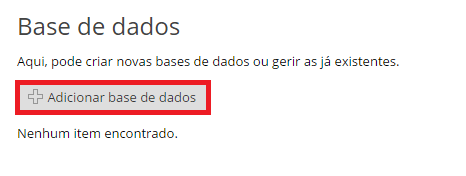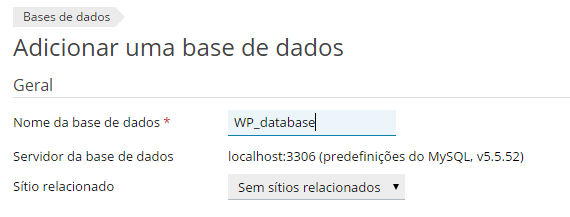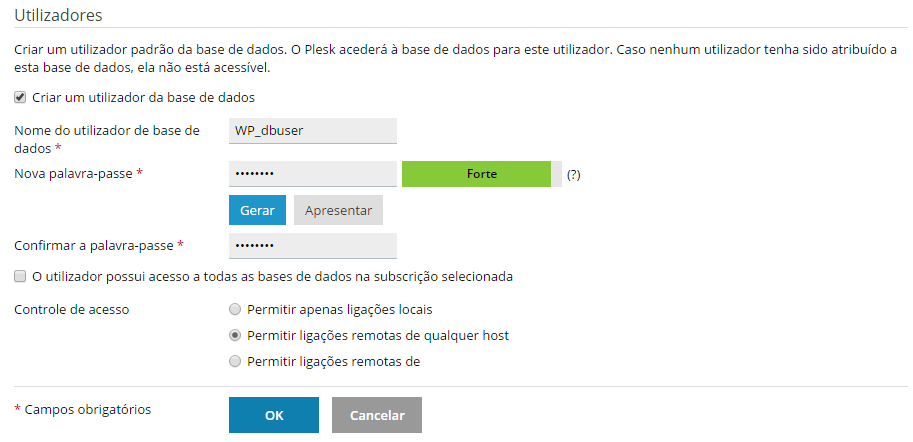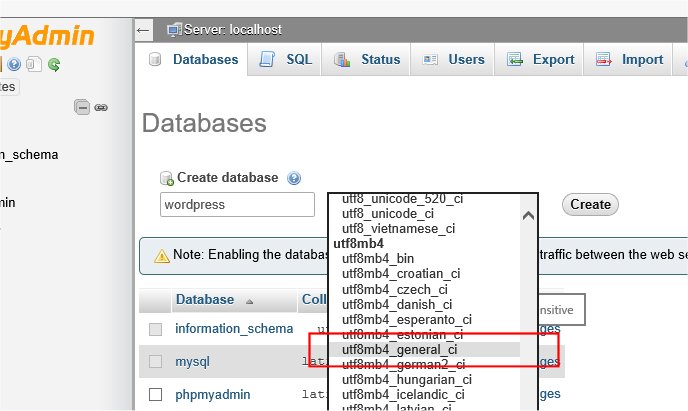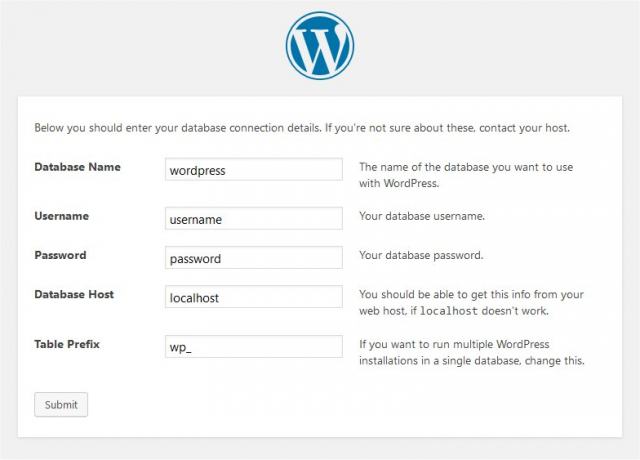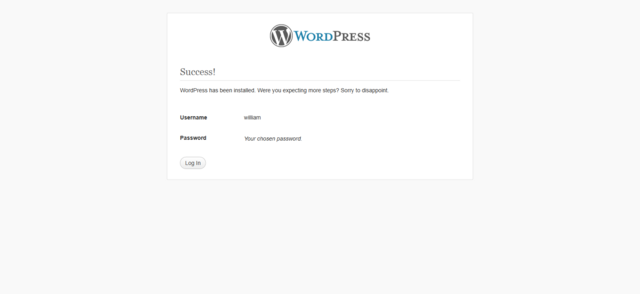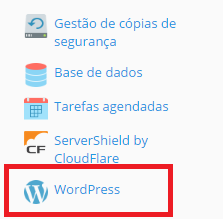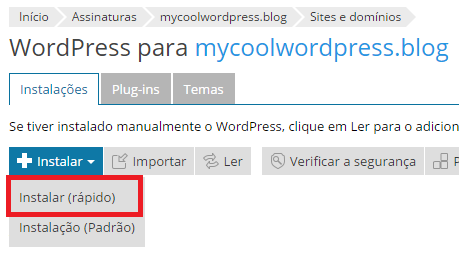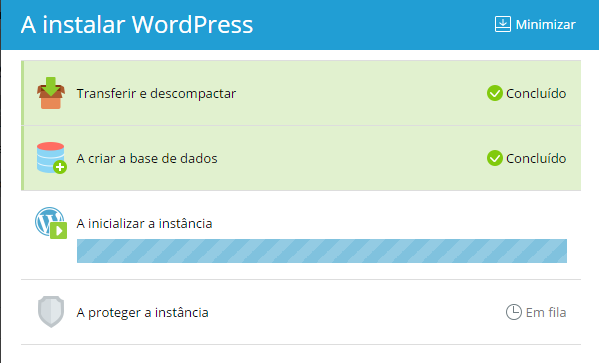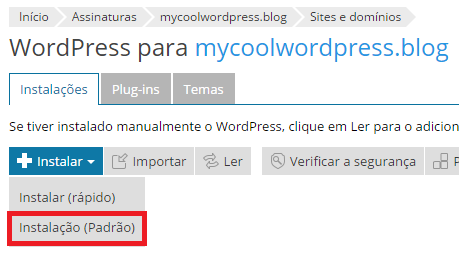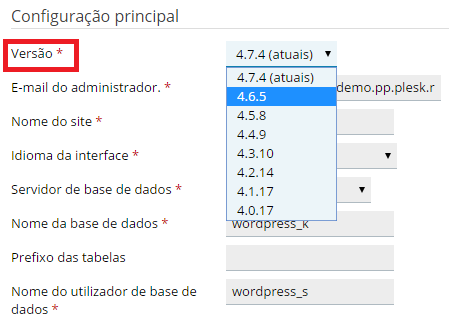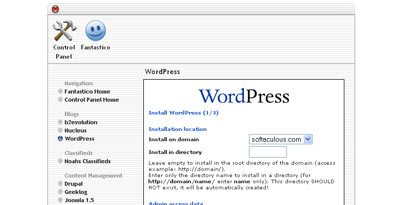pt:Instalação do WordPress
Languages: English • Español • Deutsch • বাংলা • Français • Italiano • Nederlands • のインストール 日本語 한국어 • Português do Brasil • Русский • Slovenčina • Српски • ไทย • 中文(简体) • 中文(繁體) • (Add your language)
Contents
- 1 Coisas a Saber Antes da Instalção do WordPress
- 2 A Instalação Famosa de 5 Minutos
- 3 Instruções Detalhadas
- 4 Problemas de Instalação Comuns
- 5 Automated Installation
- 6 Instalação e Instruções em Outros Idiomas
- 7 Instalação de Múltiplos Blogues
- 8 Instalação do WordPress no seu próprio Computador
- 9 Installing WordPress at popular Hosting Companies
- 10 Installing through wp-cli
- 11 Moving an Existing WordPress Blog
O WordPress é bem conhecido pela sua fácil instalação. Na maioria das circunstâncias, a instalação do WordPress é um processo muito simples e dura menos de cinco minutos para ser concluída. Agora, muitos dos hospedeiros da Web oferecem ferramentas (por exemplo, Fantastico) para instalar automaticamente o WordPress para si. Contudo, se pretender instalar você mesmo o WordPress, o guia seguinte irá ajudá-lo. Agora com a Atualização Automática é ainda mais fácil.
The following installation guide will help you, whether you go for the Famous 5 Minute Installation, or require the more detailed installation guide.
- Things to Know Before You Begin Installing WordPress
- The Famous 5-Minute Installation
- Detailed Installation Instructions
- Common Installation Problems
- Automated Installation
- WordPress in Your Language
- Installing WordPress in Your Language
- How to Install Multiple Blogs
- How to Install on Your Own Computer
- Easy 5 Minute WordPress Installation on Windows
- How to Install with Amazon's Web Services (AWS)
- How to Install at Digital Ocean on Ubuntu 14.04 LTS
- Unattended (automated) installation of WordPress on Ubuntu 16.04 LTS
- Getting Started with WordPress (much more installation info)
Coisas a Saber Antes da Instalção do WordPress
Antes de iniciar a instalação, existe algumas coisas que precisa de ter e de fazer.
Estas são:
- Access to your web server (via FTP or shell)
- A text editor
- An FTP Client
- Your web browser of choice
Coisas que Precisa de Fazer para Instalar o WordPress
Comece a sua instalação:
- Checking to ensure that you and your web host have the minimum requirements to run WordPress.
- Downloading the most current version of WordPress.
- Unzipping the downloaded file to a folder on your hard drive.
- Creating a secure password for your Secret Key
- Keeping this webpage open so you have it handy during the installation.
A Instalação Famosa de 5 Minutos
Here's the quick version of the instructions for those who are already comfortable with performing such installations. More detailed instructions follow.
If you are not comfortable with renaming files, step 3 is optional and you can skip it as the install program will create the wp-config.php file for you.
- Download and unzip the WordPress package if you haven't already.
- Create a database for WordPress on your web server, as well as a MySQL (or MariaDB) user who has all privileges for accessing and modifying it.
- (Optional) Find and rename wp-config-sample.php to wp-config.php, then edit the file (see Editing wp-config.php) and add your database information.
- Upload the WordPress files to the desired location on your web server:
- If you want to integrate WordPress into the root of your domain (e.g. http://example.com/), move or upload all contents of the unzipped WordPress directory (excluding the WordPress directory itself) into the root directory of your web server.
- If you want to have your WordPress installation in its own subdirectory on your website (e.g. http://example.com/blog/), create the blog directory on your server and upload the contents of the unzipped WordPress package to the directory via FTP.
- Note: If your FTP client has an option to convert file names to lower case, make sure it's disabled.
- Run the WordPress installation script by accessing the URL in a web browser. This should be the URL where you uploaded the WordPress files.
- If you installed WordPress in the root directory, you should visit: http://example.com/
- If you installed WordPress in its own subdirectory called blog, for example, you should visit: http://example.com/blog/
E é tudo! O WordPress deverá estar agora instalado.
Instruções Detalhadas
Passo 1: Transferir e Extrair
Download and unzip the WordPress package from https://wordpress.org/download/.
- If you will be uploading WordPress to a remote web server, download the WordPress package to your computer with a web browser and unzip the package.
- If you will be using FTP, skip to the next step - uploading files is covered later.
- If you have shell access to your web server, and are comfortable using console-based tools, you may wish to download WordPress directly to your web server using wget (or lynx or another console-based web browser) if you want to avoid FTPing:
- wget https://wordpress.org/latest.tar.gz
- Then unzip the package using:
tar -xzvf latest.tar.gz
The WordPress package will extract into a folder called wordpress in the same directory that you downloaded latest.tar.gz.
Passo 2: Criar a Base de Dados e um Utilizador
If you are using a hosting provider, you may already have a WordPress database set up for you, or there may be an automated setup solution to do so. Check your hosting provider's support pages or your control panel for clues about whether or not you'll need to create one manually.
If you determine that you'll need to create one manually, follow the instructions for accessing phpMyAdmin on various servers, or follow the instructions for Using Plesk, Using cPanel or Using phpMyAdmin below.
If you are installing WordPress on your own web server, follow the Using phpMyAdmin or Using the MySQL Client instructions below to create your WordPress username and database.
If you have only one database and it is already in use, you can install WordPress in it - just make sure to have a distinctive prefix for your tables to avoid over-writing any existing database tables.
Utilizando Plesk
Nota: O Plesk recomenda que todos os utilizadores instalem e administrem o WordPress utilizando o WordPress Toolkit. No entanto, se pretender instalar o WordPress manualmente, siga estes passos para criar uma base de dados:
- Entre no Plesk.
- No canto superior direito do ecrã, clique em Bases de dados.
- Clique em Adicionar Base de dados.
- Introduza o nome da base de dados.
- Introduza o nome de utilizador e a palavra-passe da base de dados e clique em Ok.
Quando a base de dados for criada, pode clicar em Informações da ligação para ver o servidor anfitrião e a porta da base de dados e o nome de utilizador da base de dados.

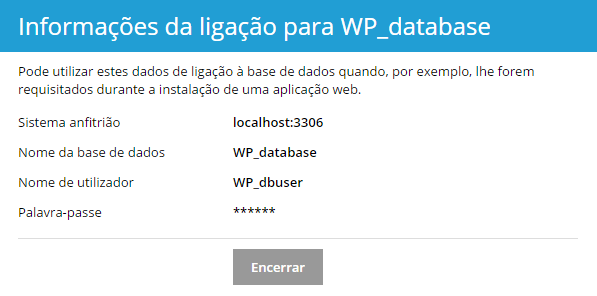
Utilizando cPanel
If your hosting provider supplies the cPanel hosting control panel, you may follow these simple instructions to create your WordPress username and database. A more complete set of instructions for using cPanel to create the database and user can be found in Using cPanel.
- Log in to your cPanel.
- Click MySQL Database Wizard icon under the Databases section.
- In Step 1. Create a Database enter the database name and click Next Step.
- In Step 2. Create Database Users enter the database user name and the password. Make sure to use a strong password. Click Create User.
- In Step 3. Add User to Database click the All Privileges checkbox and click Next Step.
- In Step 4. Complete the task note the database name and user. Write down the values of hostname, username, databasename, and the password you chose. (Note that hostname will usually be localhost.)
Utilizando cPanel personalizado (LPCP) de Lunarpages.com
Lunarpages desenvolveu a sua própria versão do cPanel.
- Log in to your account.
- Go to Control Panel.
- Click on the button on the left panel labeled 'Go to LPCP'.
- Go to MySQL Manager.
- Add the user name and database name but leave the host name as the default IP number.
- Note the IP address of the database on the right which is different from the default IP number of the host indicated in the above step.
- When modifying the WP-CONFIG.PHP file, use the DB IP number, not 'LOCALHOST'.
- When modifying the WP-CONFIG.PHP file, be sure to use the full name of the database and user name, typically 'accountname_nameyoucreated'.
- Refer to http://wiki.lunarpages.com/Create_and_Delete_MySQL_Users_in_LPCP for more info.
Utilizando phpMyAdmin
If your web server has phpMyAdmin installed, you may follow these instructions to create your WordPress username and database. If you work on your own computer, on most Linux distributions you can install PhpMyAdmin automatically.
Note: These instructions are written for phpMyAdmin 3.5; the phpMyAdmin user interface can vary slightly between versions.
- If a database relating to WordPress does not already exist in the Database dropdown on the left, create one:
- Choose a name for your WordPress database: 'wordpress' or 'blog' are good, but most hosting services (especially shared hosting) will require a name beginning with your username and an underscore, so, even if you work on your own computer, we advise that you check your hosting service requirements so that you can follow them on your own server and be able to transfer your database without modification. Enter the chosen database name in the Create database field and choose the best collation for your language and encoding. In most cases it's better to choose in the "utf8_" series and, if you don't find your language, to choose "utf8mb4_general_ci" (Reference: [1]).
- Click the phpMyAdmin icon in the upper left to return to the main page, then click the Users tab. If a user relating to WordPress does not already exist in the list of users, create one:
- Click Add user.
- Choose a username for WordPress ('wordpress' is good) and enter it in the User name field. (Be sure Use text field: is selected from the dropdown.)
- Choose a secure password (ideally containing a combination of upper- and lower-case letters, numbers, and symbols), and enter it in the Password field. (Be sure Use text field: is selected from the dropdown.) Re-enter the password in the Re-type field.
- Write down the username and password you chose.
- Leave all options under Global privileges at their defaults.
- Click Go.
- Return to the Users screen and click the Edit privileges icon on the user you've just created for WordPress. In the Database-specific privileges section, select the database you've just created for WordPress under the Add privileges to the following database dropdown. The page will refresh with privileges for that database. Click Check All to select all privileges, and click Go.
- On the resulting page, make note of the host name listed after Server: at the top of the page. (This will usually be localhost.)
Utilizando o Cliente MySQL
You can create MySQL/MariaDB users and databases quickly and easily by running mysql from the shell. The syntax is shown below and the dollar sign is the command prompt:
$ mysql -u adminusername -p
Enter password:
Welcome to the MySQL monitor. Commands end with ; or \g.
Your MySQL connection id is 5340 to server version: 3.23.54
Type 'help;' or '\h' for help. Type '\c' to clear the buffer.
mysql> CREATE DATABASE databasename;
Query OK, 1 row affected (0.00 sec)
mysql> GRANT ALL PRIVILEGES ON databasename.* TO "wordpressusername"@"hostname"
-> IDENTIFIED BY "password";
Query OK, 0 rows affected (0.00 sec)
mysql> FLUSH PRIVILEGES;
Query OK, 0 rows affected (0.01 sec)
mysql> EXIT
Bye
$
O exemplo mostra:
- that root is also the adminusername. It is a safer practice to choose a so-called "mortal" account as your mysql admin, so that you are not entering the command "mysql" as the root user on your system. (Any time you can avoid doing work as root you decrease your chance of being exploited.) The name you use depends on the name you assigned as the database administrator using mysqladmin.
- wordpress or blog are good values for databasename.
- wordpress is a good value for wordpressusername but you should realize that, since it is used here, the entire world will know it, too.
- hostname will usually be localhost. If you don't know what this value should be, check with your system administrator if you are not the admin for your WordPress host. If you are the system admin, consider using a non-root account to administer your database.
- password should be a difficult-to-guess password, ideally containing a combination of upper- and lower-case letters, numbers, and symbols. One good way of avoiding the use of a word found in a dictionary is to use the first letter of each word in a phrase that you find easy to remember.
If you need to write these values somewhere, avoid writing them in the system that contains the things protected by them. You need to remember the value used for databasename, wordpressusername, hostname, and password. Of course, since they are already in (or will be shortly) your wp-config.php file, there is no need to put them somewhere else, too.
Utilizando DirectAdmin
a. If you're a regular User of a single-site webhosting account, you can log in normally. Then click MySQL Management. (If this is not readily visible, perhaps your host needs to modify your "package" to activate MySQL.) Then follow part "c" below.
b. Reseller accounts Admin accounts may need to click User Level. They must first log in as Reseller if the relevant domain is a Reseller's primary domain... or log in as a User if the domain is not a Reseller's primary domain. If it's the Reseller's primary domain, then when logged in as Reseller, simply click User Level. However if the relevant domain is not the Reseller's primary domain, then you must log in as a User. Then click MySQL Management. (If not readily visible, perhaps you need to return to the Reseller or Admin level, and modify the "Manage user package" or "Manage Reseller package" to enable MySQL.)
c. In MySQL Management, click on the small words: Create new database. Here you are asked to submit two suffixes for the database and its username. For maximum security, use two different sets of 4-6 random characters. Then the password field has a Random button that generates an 8-character password. You may also add more characters to the password for maximum security. Click Create. The next screen will summarize the database, username, password and hostname. Be sure to copy and paste these into a text file for future reference.
Passo 3: Configurar wp-config.php
You can either create and edit the wp-config.php file yourself, or you can skip this step and let WordPress try to do this itself when you run the installation script (step 5) (you’ll still need to tell WordPress your database information).
(For more extensive details, and step by step instructions for creating the configuration file and your secret key for password security, please see Editing wp-config.php.)
Return to where you extracted the WordPress package in Step 1, rename the file wp-config-sample.php to wp-config.php, and open it in a text editor.
Enter your database information under the section labeled
// ** MySQL settings - You can get this info from your web host ** //
- DB_NAME
- The name of the database you created for WordPress in Step 2.
- DB_USER
- The username you created for WordPress in Step 2.
- DB_PASSWORD
- The password you chose for the WordPress username in Step 2.
- DB_HOST
- The hostname you determined in Step 2 (usually localhost, but not always; see some possible DB_HOST values). If a port, socket, or pipe is necessary, append a colon (:) and then the relevant information to the hostname.
- DB_CHARSET
- The database character set, normally should not be changed (see Editing wp-config.php).
- DB_COLLATE
- The database collation should normally be left blank (see Editing wp-config.php).
Enter your secret key values under the section labeled
* Authentication Unique Keys.
Save the wp-config.php file.
For information on enabling SSL in WordPress 2.6, see SSL and Cookies in WordPress 2.6.
Passo 4: Enviar os seu ficheiros
Now you will need to decide where on your domain you'd like your WordPress-powered site to appear:
- In the root directory of your website. (For example, http://example.com/)
- In a subdirectory of your website. (For example, http://example.com/blog/)
Note: The location of your root web directory in the filesystem on your web server will vary across hosting providers and operating systems. Check with your hosting provider or system administrator if you do not know where this is.
Na Diretoria Raiz
- If you need to upload your files to your web server, use an FTP client to upload all the contents of the wordpress directory (but not the directory itself) into the root directory of your website.
- If your files are already on your web server, and you are using shell access to install WordPress, move all of the contents of the wordpress directory (but not the directory itself) into the root directory of your website.
Numa Subdiretoria
- If you need to upload your files to your web server, rename the wordpress directory to your desired name, then use an FTP client to upload the directory to your desired location within the root directory of your website.
- If your files are already on your web server, and you are using shell access to install WordPress, move the wordpress directory to your desired location within the root directory of your website, and rename the directory to your desired name.
Nota: If your FTP client has an option to convert file names to lower case, make sure it's disabled.
Passo 5: Executar o Script de Instalação
Point a web browser to start the installation script.
- If you placed the WordPress files in the root directory, you should visit: http://example.com/wp-admin/install.php
- If you placed the WordPress files in a subdirectory called blog, for example, you should visit: http://example.com/blog/wp-admin/install.php
Configurar ficheiro de configuração
If WordPress can't find the wp-config.php file, it will tell you and offer to try to create and edit the file itself. (You can also do this directly by loading wp-admin/setup-config.php in your web browser.) WordPress will ask you the database details and write them to a new wp-config.php file. If this works, you can go ahead with the installation; otherwise, go back and create, edit, and upload the wp-config.php file yourself (step 3).
Terminar a instalação
The following screenshots show how the installation progresses. Notice that in entering the details screen, you enter your site title, your desired user name, your choice of a password (twice), and your e-mail address. Also displayed is a check-box asking if you would like your blog to appear in search engines like Google and Technorati. Leave the box checked if you would like your blog to be visible to everyone, including search engines, and uncheck the box if you want to block search engines, but allow normal visitors. Note all this information can be changed later in your Administration Panels.
Instalar a resolução de problemas de script
- If you get an error about the database when you run the install script:
Problemas de Instalação Comuns
The following are some of the most common installation problems. For more information and troubleshooting for problems with your WordPress installation, check out FAQ Installation and FAQ Troubleshooting.
I see a directory listing rather than a web page.
The web server needs to be told to view index.php by default. In Apache, use the DirectoryIndex index.php directive. The simplest option is to create a file named .htaccess in the installed directory and place the directive there. Another option is to add the directive to the web server's configuration files.
I see lots of Headers already sent errors. How do I fix this?
You probably introduced a syntax error in editing wp-config.php.
- Download wp-config.php (if you don't have shell access).
- Open it in a text editor.
- Check that the first line contains nothing but <?php, and that there is no text before it (not even whitespace).
- Check that the last line contains nothing but ?>, and that there is no text after it (not even whitespace).
- If your text editor saves as Unicode, make sure it adds no byte order mark (BOM). Most Unicode-enabled text editors do not inform the user whether or not it adds a BOM to files; if so, try using a different text editor.
- Save the file, upload it again if necessary, and reload the page in your browser.
My page comes out gibberish. When I look at the source I see a lot of "<?php ?>" tags.
If the <?php ?> tags are being sent to the browser, it means your PHP is not working properly. All PHP code is supposed to be executed before the server sends the resulting HTML to your web browser. (That's why it's called a preprocessor.) Make sure your web server meets the requirements to run WordPress, that PHP is installed and configured properly, or contact your hosting provider or system administrator for assistance.
I keep getting an Error connecting to database message but I'm sure my configuration is correct.
Try resetting your MySQL/MariaDB password manually. If you have access to MySQL/MariaDB via shell, try issuing:
SET PASSWORD FOR 'wordpressusername'@'hostname' = OLD_PASSWORD('password');
If you are using a version of MySQL prior to 4.1, use PASSWORD instead of OLD_PASSWORD. If you do not have shell access, you should be able to simply enter the above into an SQL query in phpMyAdmin. Failing that, you may need to use your host's control panel to reset the password for your database user.
I keep getting an Your PHP installation appears to be missing the MySQL extension which is required by WordPress message but I'm sure my configuration is correct.
Check to make sure that your configuration of your web-server is correct and that the MySQL plugin is getting loaded correctly by your web-server program. Sometimes this issue requires everything in the path all the way from the web-server down to the MySQL/MariaDB installation to be checked and verified to be fully operational. Incorrect configuration files or settings are often the cause of this issue.
My image/MP3 uploads aren't working.
If you use the Rich Text Editor on a blog that's installed in a subdirectory, and drag a newly uploaded image into the editor field, the image may vanish a couple seconds later. This is due to a problem with TinyMCE (the rich text editor) not getting enough information during the drag operation to construct the path to the image or other file correctly. The solution is to NOT drag uploaded images into the editor. Instead, click and hold on the image and select Send to Editor.
Automated Installation
Although WordPress is very easy to install, you can use one of the one-click autoinstallers typically available from hosting companies. The most popular autoinstallers, APS, Cloudron, Fantastico, Installatron, and Softaculous are described here.
Plesk WordPress Toolkit
WordPress Toolkit é uma ferramenta que ajuda a instalar e a gerir o WordPress. Dá-lhe duas opções de instalação:
- Rápida (recomendado) – uma opção rápida, apenas com três cliques, que executa uma instalação do WordPress totalmente funcional e pronta em menos de um minuto. A instalação será configurada com as predefinições e utilizará a versão mais recente do WordPress.
- Personalizada - esta opção permite-lhe selecionar a versão do WordPress desejada e manipular as definições de instalação, tratando de todo o trabalho mais complicado.
Note que é responsável por se certificar de que o seu domínio cumpre os requisitos da instalação WordPress (por exemplo, que uma versão PHP suportada está configurada).
Para realizar a instalação rápida, siga estes passos:
- Entre no Plesk.
- No canto superior direito do ecrã, clique em WordPress.
- Clique em Instalar > Instalar (rápido).
- A instalação foi iniciada.
- Em poucos segundos, a instalação será concluída. Clique Entrar para introduzir a sua primeira publicação!
Para realizar a instalação personalizada, siga estes passos:
- Entre no Plesk.
- No canto superior direito do ecrã, clique em WordPress.
- Clique em Instalar > Instalação (Padrão).
- Na janela aberta da Instalação do WordPress, selecione a versão do WordPress pretendida
- Preencha todos os campos obrigatórios (assinalados com asterisco).
- Faça as alterações que desejar às predefinições e clique em Instalar quando estiver pronto.
- A instalação foi iniciada.
- Em poucos segundos, a instalação será concluída. Clique Entrar para introduzir a sua primeira publicação!
Independentemente do tipo de instalação que escolheu, o WordPress Toolkit pode facilitar a gestão da sua instalação do WordPress. Leia a documentação para mais informação.
Cloudron
Cloudron is a smartserver on which you can install web apps like WordPress. You can install WordPress into a custom domain and each installation gets a free SSL cert, is backed up and kept up-to-date automatically.
Fantastico
- Log in to your cPanel account and click on the Fantastico (or Fantastico Deluxe) option.
- Once you enter Fantastico, on the left hand side there is a Blogs category under which you will find WordPress. Click on it.
- Click on the New Installation link in the WordPress Overview.
- Fill in the various details and click Submit.
- That's it, you are done!
Installatron
Installatron is a one-click web application installer that enables WordPress and other top web applications to be instantly installed and effortlessly managed. WordPress installations managed by Installatron can be updated (manually or automated), cloned, backed up and restored, edited to change installation parameters, and more.
Many web hosting providers include Installatron through their web hosting control panel. If Installatron is not available from your provider, you can use Installatron directly from Installatron.com.
Here's how to install WordPress through your web hosting provider's control panel:
- Log in to your web host's control panel, navigate to "Installatron," click WordPress, and choose the Install this application option.
- Change any of the install prompts to customize the install. For example, you can choose a different language for WordPress.
- Click the Install button to begin the installation process. You will be redirected to a progress page where you can watch as WordPress is installed within a few seconds to your website.
Here's how to install WordPress using Installatron.com:
- Navigate to Installatron WordPress and choose the Install this application option.
- Enter your hosting account's FTP or SSH account information, and then enter MySQL/MariaDB database information for a created database. For increased security, create a separate FTP account and MySQL/MariaDB database for your WordPress installation.
- Change any of the install prompts to customize the install. For example, you can choose a different language for WordPress.
- Click the Install button to begin the installation process. You will be redirected to a progress page where you can watch as WordPress is installed within a few seconds to your website.
Softaculous
- Log in to your host and look for Software/Services.
- In Softaculous, there is a Blogs category. Collapse the category and WordPress will be there. Click on it.
- You will see an Install TAB. Click it.
- Fill in the various details and submit.
- That's it, you are done!
Instalação e Instruções em Outros Idiomas
Para instruções de instalação em outros idiomas, consulte WordPress no Seu Idioma.
Instalação de Múltiplos Blogues
- Detailed information about Installing Multiple Blogs is available.
- Clone a WordPress Blog Clone existing installations in a minute with this simple bash script for Linux.
Instalação do WordPress no seu próprio Computador
Instruções de Instalação Local
Use these instruction for setting up a local server environment for testing and development.
Installing WordPress locally is usually meant for the purpose of development. Those interested in development should follow the instructions below and download WordPress locally.
- AMPPS: Free WAMP/MAMP/LAMP stack, with inbuilt Softaculous Installer. Can 1 click install and upgrade WordPress and others as well.
- DesktopServer Limited: Free Windows/Macintosh server, creates multiple virtual servers with fictitious top level domains (i.e. www.example.dev) specifically for working on multiple WordPress projects.
- Mac App Store 1-click install for WordPress Installs a free, self-contained all-in-one bundle of WordPress and everything it needs to run: MySQL/MariaDB, Apache and PHP
- Installing WordPress Locally on Your Mac With MAMP
- User:Beltranrubo/BitNami Free all-in-one installers for OS X, Windows and Linux. There are also available installers for WordPress Multisite User:Beltranrubo/BitNami_Multisite using different domains or subdomains.
- Instant WordPress is a free, standalone, portable WordPress development environment for Windows that will run from a USB key.
Software Appliance - Ready-to-Use
You may find that using a pre-integrated software appliance is a great way to get up and running with WordPress, especially in combination with virtual machine software (e.g., VMWare, VirtualBox, Xen HVM, KVM).
Another software that can be used is Parallels, which you would have to pay for unlike virtual machine software. It allows you to run both Mac and Windows on your machine.
A software appliance allows users to altogether skip manual installation of WordPress and its dependencies, and instead deploy a self-contained system that requires little to no setup, in just a couple of minutes.
- TurnKey WordPress Appliance: a free Debian-based appliance that just works. It bundles a collection of popular WordPress plugins and features a small footprint, automatic security updates, SSL support and a Web administration interface. Available as ISO, various virtual machine images, or launch in the cloud.
- BitNami WordPress Appliance: free WordPress appliances based on Ubuntu or Open Suse. Native installer and Cloud images also available. There are also virtual machines for WordPress Multisite already configured.
- UShareSoft WordPress Appliance: free WordPress appliance for many of the major virtualization and cloud platforms (Cloud.com, Xen, VMware, OVF, Abiquo)
Easy 5 Minute WordPress Installation on Windows
Download, install, and configure WordPress with the Microsoft Web Platform Installer (Web PI). Installation is very easy and takes on average about 5 minutes to complete. For other Windows installers, check this section.
- Step 1. Things you need to know before starting
- These steps will work on Windows versions which include IIS, such as Windows XP professional, Windows Vista, Windows 7, Windows 8 and Windows Server.
- You must be able to install programs on your machine (i.e. have administrator rights).
- Once Web PI is installed, neither XAMPP nor any other web server will be able to use localhost to host a website locally on your machine.
- Step 2. Navigate to the WordPress Installation Page
- Choose the "Install" button.
- If you have Web PI already installed, it will automatically be launched and you can skip to the next step.
- If you do not have the Web Platform Installer, you will be prompted to install it.
- Web PI is a tool from Microsoft that downloads and installs the latest components you need to develop or host Web applications on Windows. Everything in the tool is free. Web PI will install and configure IIS, PHP, MySQL/MariaDB and anything else you may need.
- Step 3. Choose to Install WordPress
- When Web PI launches, you will see an information page for WordPress. Start installing WordPress by pressing the "Install" button in the lower right hand corner.
- Step 4. Installation of WordPress and its requirements
- Finding Dependencies: Web PI will determine the minimum set of components and modules you need on your machine to run WordPress. It will only install what you’re missing. For example, PHP will be installed and configured to run WordPress.
- Configure the Database: After accepting the terms, if you need to install MySQL/MariaDB, you will be asked to create a password for the root account database account. Keep this password safe. WordPress will ask for this information later.
- Choose the site: Choose a site to install WordPress to. You may install to an existing website in IIS or create a new site. Use the default setting if you do not have advanced configuration needs.
- WordPress Setup: WordPress will need answers to a few specific questions such as the username (in the case of a new MySQL/MariaDB install is root) and password for your MySQL/MariaDB database to complete the install.
- Step 5. Completion
- Once you enter the WordPress setup information, Web PI will finish the installation.
- Click, Launch in Browser and WordPress will launch.
Alternatively, the BitNami WordPress installer is a free, self-contained native installer for WordPress that includes Apache, MySQL and PHP so it works out of the box.
Unattended/automated installation of WordPress on Ubuntu Server 16.04 LTS
Unattended installation of WordPress on Ubuntu Server [2]
You can follow this guide by copy & pasting commands in a terminal to set up WordPress on a fresh Ubuntu Server 16.04 installation with nginx, PHP7, MySQL plus free SSL from LetsEncrypt.
You will not be prompted to enter any credentials or details like in other guides, everything is automated. You can even skip the installation wizard.
WAMP
If you don't have IIS on your computer or don't want to use it, you could use a WAMP Stack :
- WAMP Server or WAMP Server at SourceForge
- AMPPS WAMPStack - has Softaculous WordPress Installer
- EasyPHP - Has WordPress installer plugin
- BitNami WAMPStack - Has WordPress stack
- XAMPP WAMPStack
These stacks can be downloaded freely and set up all the bits you need on your computer to run a website. Once you have downloaded and installed WAMP, you can point your browser at localhost and use the link to phpmyadmin to create a database.
Then, in order to install WordPress, download the zip file, and extract it into the web directory for your WAMP installation (this is normally installed as c:\wamp\www). Finally visit http://localhost/wordpress to start the WordPress install. (Assuming you extracted into c:\wamp\www\wordpress).
Tip: If you want to use anything other than the default permalink structure on your install, make sure you enable the mod_rewrite module in WAMP. This can be enabled by clicking on the WAMP icon in the taskbar, then hover over Apache in the menu, then Apache modules and ensure that the rewrite_module item has a checkmark next to it.
Installing WordPress at popular Hosting Companies
Installing WordPress at Atlantic.Net
You can also install WordPress on Ubuntu with one click WordPress Hosting on Atlantic.Net.
Installing WordPress at AWS
- Installatron WordPress Installatron WordPress is a pre-configured and ready-to-launch image that contains a WordPress website and Installatron's WordPress management tools.
- Architecting a Highly Scalable WordPress Site in AWS A guide for building a more expensive, highly scalable AWS implementation using Amazon's Relational Data Store (RDS) et al.
Installing WordPress at DigitalOcean
Installing WordPress at Linode
- Manage Web Content with WordPress Install WordPress on a Debian Server with a LAMP Stack
You can also install WordPress on Ubuntu with one click using this StackScript on Linode.
Installing WordPress at iPage Hosting
- This is a great step by step tutorial by IStartBlogging on how to setup your blog the smart way with iPage Hosting.
In less than 5 minutes from now, you will have your blog ready on your domain. You will install WordPress on your own domain as an Automated Process with ONE Click WordPress Installation feature from iPage hosting.
Installing WordPress at Microsoft Azure
- Installing WordPress on Microsoft Azure is as simple as a few clicks. A hosting space and MySQL database will be created and configured, so you're ready to start creating within a matter of seconds.
- Microsoft Azure Scalable WordPress provides a WordPress installation that has been customized to follow best practices for a highly scalable WordPress site in minutes.
- Running into some issues and need to troubleshoot your WordPress site on Azure? Follow this handy Troubleshooting guide for WordPress on Azure
- There is a full listing of resources on how to learn more about WordPress on Microsoft Azure!
Installing through wp-cli
wp-cli is a great command line tool with which you can easily install and update WordPress and themes and extensions.
Moving an Existing WordPress Blog
- Moving WordPress The WordPress codex guide to migrating your WordPress blog.
- Migrating a WordPress blog to Amazon. A technical tutorial on moving your WordPress blog to Bitnami's AWS configuration.

